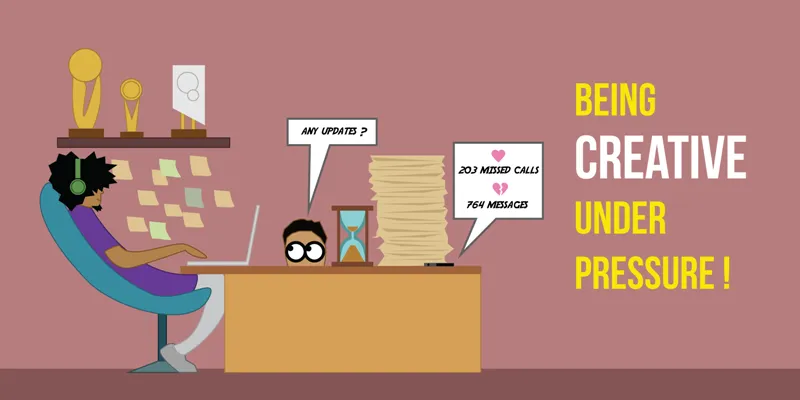Once on Apollo’s flight to the moon, an explosion occurred which led to a dangerous build-up of carbon dioxide in the cabin. If the system was not fixed or replaced, the astronauts would be dead within a few hours. With little time to spare, the engineers from NASA built an air filter using basic things present on the spacecraft: like plastic bags, the flight manual, and duct tape. Unconventional and far from perfect but it seemed like it might just do the job. And it did. The simple idea saved lives. Call it presence of mind, intelligence, or perhaps sheer luck, but it was undeniably one thing for sure -- creative.
What does this tell us about creativity?
Creativity not only involves brainstorming for ideas but also executing them; so if you have ideas but are not executing them, you are imaginative, but not creative.
For most of us, work may not be life threatening, but with many things going on in our heads, none of us have the luxury of time anymore; we have to be spontaneous, we have to be creative. Though researchers have repeatedly said that the most favourable condition for creativity is a place without time-pressure constraint, sadly none of these research scientists are our clients.

So that’s that. Pressure is going to be a part of our daily lives. But how do you stay creative when you are up against it? Here are a few ideas to stay productive and creative in difficult circumstances:
Define the challenge
Take a few minutes to observe a water bottle, note down the details you observed. Now remove the bottle top and observe only the top for a minute. Don’t you see a lot of details which you never observed at first? Before looking for the right solution, define the challenge. Define the challenge in a single sentence. Then reframe and clarify the challenge. Clarity opens up avenues that you had not thought of before. It also helps you to brainstorm for ideas without much deviation.
Encourage wild ideas
While looking for a solution, always be receptive to ideasfrom others. This will bring about a sense of craziness into the brainstorming process. Go for quantity instead of quality. Because every single time you look for quality during the brainstorming stage, you start judging. In creative processes judgment should be suspended. Building on each other’s conception can foster great ideas. You never know where the next big idea is going to come from; the key is making everyone feel comfortable enough to vocalise their thoughts.
You'll also like to read: 5 reasons you will be grateful you choose to work for a startup
Break big tasks into smaller tasks
After you figure out the task, break it into sub-tasks and set a time frame for each task. Starting out with the easiest might just do the trick by giving you the necessary confidence needed to move ahead. Suppose, your dream is to write a book and you are too overwhelmed to start, what do you do? Start by writing a small paragraph then develop it into a page, then a chapter, eventually you will complete the whole book.
Simplify the complex
Now simplifying doesn’t mean dumbing things down. It just means a non-technical way of looking at things. Maintaining a calm and clear head is a survival instinct to deliver creative ideas in difficult circumstances. You have to figure out a way to acknowledge deadlines without beingstressed. You are no different from a batsman wanting a boundary on the last delivery of the match. What do you think serves him better? Thinking of details like speed of the ball, reputation of the bowler, and implications of losing the game; or focusing only on the next ball with complete trust in his abilities.
Take a break
When you are slogging out for hours at a stretch to meet a deadline, you forget to take a break-- be it a nap, grabbing a snack, or just a lazy walk. We do not need research to tell us that a hungry stomach produces unimpressive work, so eat. Meet a friend in the office, who is not related to your work. In most cases, all you need to do is break out of the mundane routine. Play a sport or get outdoors, because genius strikes subconsciouslywhen you take time out to do something different. Personally, my best ideas come when I am having a shower.
Related read: Problem solving with design thinking: 10 stories, tools and tips
Believe that you can impact at least one life
Feeling like you are on a mission helps you do amazing stuff. Doug Dietz, the man who designed the MRI machine, was proud of the lives he had saved until one day he saw a small girl crying, scared of the machine which was going to treat her. Logically, his machine did the job it was meant to, but still he was not satisfied. So he redesigned the machine to look like a pirate adventure. The only instruction the children were given was to remain still during the adventure in order to escape from the pirates. Suddenly, the percentage of kids sedated reduced from 80 per cent to 10 per cent. But the best part for Dietz was when he saw a little girl run up to her mother and say: “Mommy, can we go again tomorrow?”
Whatever people say, creativity can positively impact lives and change the world for the better. Pressure is just like snake venom, it saves lives when you have the right amount;but a slight overdose might kill you. So don’t ever let pressure drive you. Focus on doing things a little better every single time, just a little better. Remember, your moment of brilliance can change the world. And that moment is just around the corner. Focus!
(Disclaimer: The views and opinions expressed in this article are those of the author and do not necessarily reflect the views of YourStory.)







